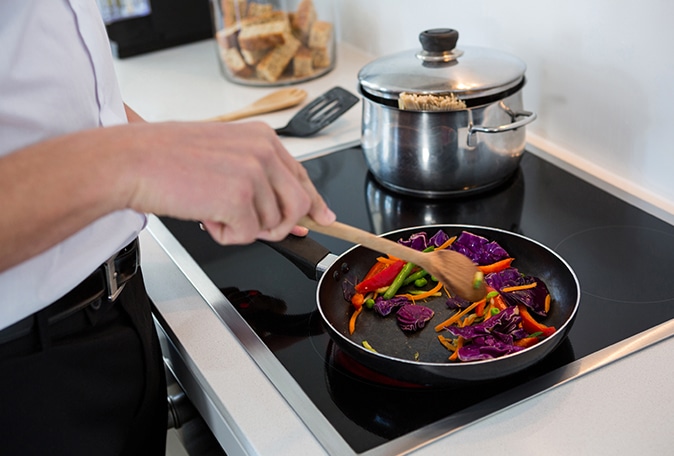Induction cooktops offer 90% energy efficiency, reducing bills and CO2 emissions, and heat twice as fast as gas ranges.
Imagine cooking faster, more efficiently, and more safely than ever before. This is the reality of induction cooktops, the next-generation kitchen innovation that uses magnetic fields to heat your cookware directly. With induction technology, you can achieve 90% energy efficiency, far superior to traditional gas or electric stoves. This not only decreases your energy bills but also your carbon footprint, promoting sustainability. What’s more, the surface remains cool to the touch, eliminating burn risk and simplifying cleanup. Your kitchen becomes a safer and more user-friendly environment. In terms of precision, induction allows for immediate temperature adjustments, ensuring your meals are cooked to perfection every time. If you desire a kitchen that’s fast, efficient, safe, and environmentally-friendly, induction cooktops are a game-changing choice.
Pros
- Energy Efficiency: Induction cooktops boast around 90% energy efficiency, far surpassing gas (40-55%) and electric ranges (65-70%). This leads to significant savings on energy bills and contributes to climate change mitigation by reducing carbon emissions.
- Safety and Control: These cooktops only heat the pot, leaving the rest of the surface cool to touch. They provide immediate response to temperature adjustments, offering unparalleled control.
- Ease of Cleaning: Induction cooktops have flat surfaces, making them easier to clean than gas stoves with their complex burner grates.
Cons
- Cost: Induction cooktops are typically more expensive upfront than gas or electric ranges, although energy savings may offset this over time.
- Cookware Limitations: They require magnetic-based cookware, such as cast iron or certain stainless steels. Not all pots and pans are compatible.
- Learning Curve: Users may need time to adjust to the quick heating and precise control of induction cooking.
Costs
1New Construction
The cost of installing an induction cooktop during new construction is typically part of the overall kitchen construction budget. The price of an induction cooktop itself ranges between $1,500 and $3,500, with luxury models going up to $5,000. Standard gas or electric cooktops can range from $500 to $1,500. Therefore, there’s a premium of approximately $1,000 to $2,000 when choosing induction.

2Existing Home - Hiring a Contractor
The cost to replace an existing cooktop with induction, including labor, can range from $1,800 to $4,500 depending on the complexity of installation (like updating wiring or countertop cutouts). The contractor’s labor usually costs around $300 to $1,000 of the total.
3Existing Home - DIY
If you have the required technical skills, you might only need to pay for the unit and additional necessary materials. These could include wiring, a dedicated circuit if needed, or modifications to your countertop, ranging approximately from $1,600 to $3,700.

Hiring Pros
- Search Online Platforms: You can try HomeAdvisor (www.homeadvisor.com), or other platforms connecting homeowners with pre-screened service professionals. Enter your location and the service required to get a list of experienced contractors. A note of caution: we have heard negative reviews about some such services.
- Check Credentials: Ensure the professional you hire is licensed and insured to conduct work in your area. This protects you from liability and guarantees a certain level of competency.
- Look at Reviews and Ratings: These can provide insight into a professional’s reliability, punctuality, and quality of work.
- Ask for References: Contacting past clients can offer firsthand accounts of their experiences, adding another layer of trust.
- Get Multiple Quotes: Don’t settle for the first quote you receive. It’s important to compare costs and services from various professionals for the best deal.

Do It Yourself
- Seek Guidance: Black & Decker The Complete Guide to Wiring, 7th Edition” (www.amazon.com/dp/1591869454) is an invaluable resource for understanding electrical projects, including induction cooktop installation.
- Understand Your Electrical System: Make sure your home’s electrical system can handle the load of an induction cooktop. You may need to upgrade your circuit breaker.
- Have the Right Tools: Most installations require wire strippers, a multimeter, screwdrivers, and more. Ensure you have all necessary tools before starting.
- Safety First: Always turn off the power at the breaker box before beginning to avoid electrical shock. If in doubt, consult a professional.
- Check Local Codes: Some municipalities require a licensed electrician to perform certain electrical work. Make sure you’re in compliance to avoid future issues.
Tips for Renters
Looking for a Rental:
1Use Specific Search Filters
Websites like www.apartments.com allow you to filter by specific amenities, like type of appliances. Utilize this feature to target rentals with induction cooktops.
2Ask in Advance
Directly ask landlords or rental agencies about the possibility of rentals with induction cooktops.
3Tour Homes
Visually inspect appliances during home tours to ensure they meet your requirements.

Convincing a Landlord:
1Highlight the Benefits
Explain the energy efficiency, safety, and potential for lower long-term maintenance costs associated with induction cooktops.
2Discuss Cost Sharing
If the upfront cost is a concern, propose sharing the cost, or incrementally increasing your rent to cover it.
3Provide References
Share articles or resources emphasizing the benefits and popularity of induction cooktops to strengthen your argument.
Tips for Designers & Builders

For the Design Team:
1Consider Space and Layout
Prioritize the layout and space utilization of the kitchen. The cooktop should be placed in a location that provides ample counter space on either side for prep work. Be mindful of the location of the sink and the refrigerator to facilitate an efficient workflow.
2Electrical Specifications
Design the kitchen with the appropriate electrical infrastructure. Induction cooktops often require a dedicated 240-volt circuit, so this needs to be considered during the electrical layout phase of design.
3Aesthetics and Functionality
Induction cooktops offer a sleek look and can be well-integrated into modern kitchen designs. Ensure the cooktop complements other appliances and the overall aesthetic of the kitchen.

For the Builder:
1Understand the Electrical Requirements
Ensure that the wiring, voltage, and breaker are compatible with the specifications of the induction cooktop. Any electrical work should comply with local building codes.
2Proper Installation
The cooktop needs to be perfectly level for optimal operation. Use a high-quality sealant to prevent any water or debris from entering the countertop cutout.
3Safety Measures
Always disconnect the power before installation. Given the high voltages involved with induction cooktops, safety should be a top priority. If the installation crew isn’t skilled in electrical work, hiring a licensed electrician would be prudent.
1Consider Space and Layout
Prioritize the layout and space utilization of the kitchen. The cooktop should be placed in a location that provides ample counter space on either side for prep work. Be mindful of the location of the sink and the refrigerator to facilitate an efficient workflow.
1Understand the Electrical Requirements
Ensure that the wiring, voltage, and breaker are compatible with the specifications of the induction cooktop. Any electrical work should comply with local building codes.
2Electrical Specifications
Design the kitchen with the appropriate electrical infrastructure. Induction cooktops often require a dedicated 240-volt circuit, so this needs to be considered during the electrical layout phase of design.
2Proper Installation
The cooktop needs to be perfectly level for optimal operation. Use a high-quality sealant to prevent any water or debris from entering the countertop cutout.
3Aesthetics and Functionality
Induction cooktops offer a sleek look and can be well-integrated into modern kitchen designs. Ensure the cooktop complements other appliances and the overall aesthetic of the kitchen.
3Safety Measures
Always disconnect the power before installation. Given the high voltages involved with induction cooktops, safety should be a top priority. If the installation crew isn’t skilled in electrical work, hiring a licensed electrician would be prudent.
Resources
Books:
“The Best Induction Burner Recipes on the Planet: 100 Easy Recipes for Your Portable Cooktop” by Ella Sanders.
“Kitchen and Bath Sustainable Design: Conservation, Materials, Practices” by Amanda Davis.
Websites:
U.S. Department of Energy: Making the Switch to Induction Stoves or Cooktops: https://www.energy.gov/articles/making-switch-induction-stoves-or-cooktops
- U.S. Environmental Protection Agency (EPA)- ENERGY STAR – 2021-2022 Residential Induction Cooking Tops: https://www.energystar.gov/partner_resources/brand_owner_resources/spec_dev_effort/2021_residential_induction_cooking_tops





